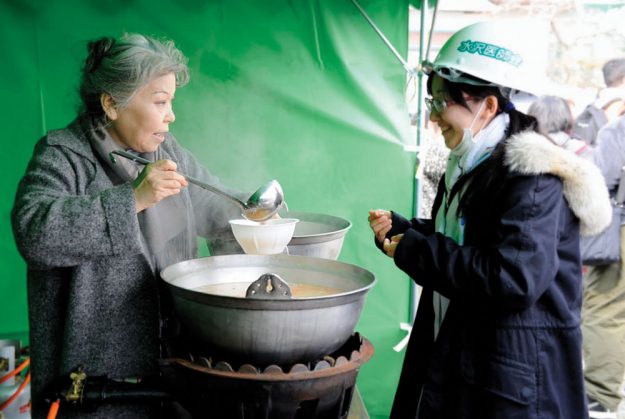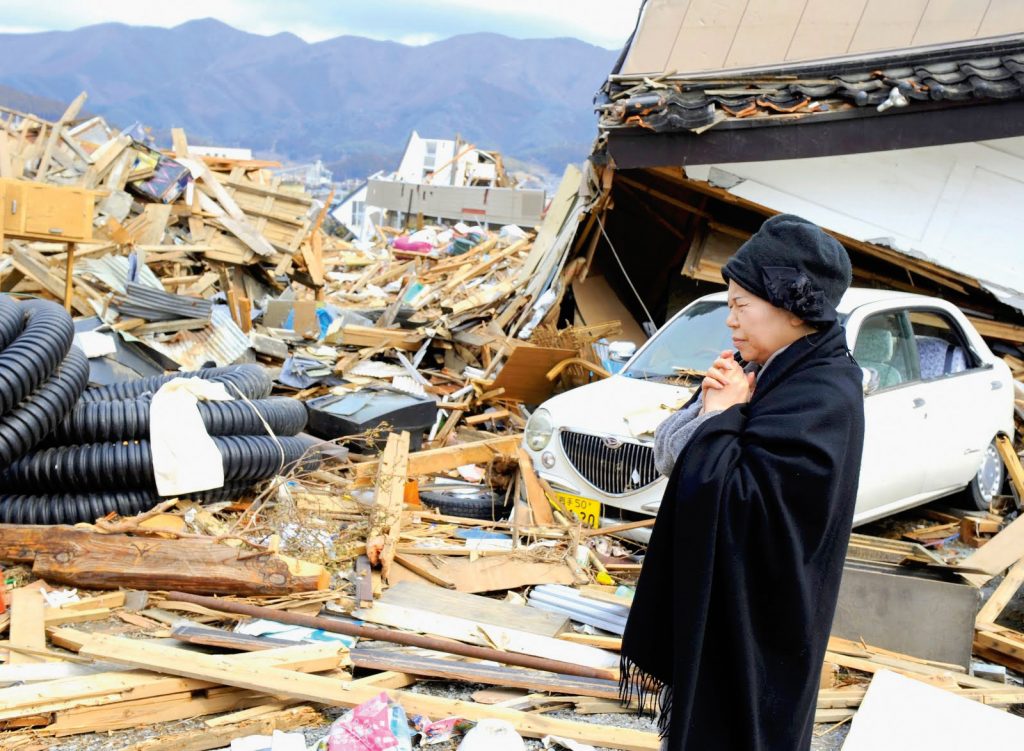Shinjo Ito, the founder of Shinnyo-en Buddhism, a Japanese Vajrayana school, once wrote, “Faith is not about preaching or philosophy. It is action to which you dedicate your whole being.” Shinnyo-en Buddhists strive to consider the hardships of others as their own and then meditate on how to respond. Reacting to the recent events in Japan—or to any disaster—is not about asking “Why?” but rather “What can I do?”
Immediately following the earthquake, Shinnyo-en began providing humanitarian and financial aid to victims. By the end of March, 11 teams from Shinnyo-en Relief Volunteers (SeRV) had been dispatched to the affected areas, working closely with the Japan National Council of Social Welfare (JNCSW). Her Holiness Shinso Ito, the current head of Shinnyo-en, visited the towns of Rikuzentakata and Ofunato in Iwate Prefecture and the Volunteer Relief Center that Shinnyo-en helped set up. Both Rikuzentakata and Ofunato were almost completely destroyed, and the residents were experiencing unprecedented suffering. With the help of SeRV members, Shinso delivered a much-needed supply of fresh vegetables and other essential supplies to a local shelter. “For priests,” Shinso says, “to pray and meditate for others constitutes our primary contribution, but we will do anything and everything we can to help here.”

Shinnyo-en is offering prayers, every day and throughout the day, for all the missing and injured in Japan. Through services, Shinnyo-en Buddhists believe, the blessings of the ever-present buddhas flow to those whose lives were lost. The Dispelling the Darkness rites offer spiritual consolation and transfer merit to the deceased in accordance with the profoundest mysteries of the Nirvana Dharma.
A passage in the Nirvana Sutra, the Shinnyo-en school’s foundational text, reads, “The life of a tathagata [a buddha] will enlighten the lives of many people, and dispel the darkness around them. Through the spiritual light of a tathagata, the pain and suffering of sentient beings can be lifted away.” The Nirvana Sutra also teaches that all beings have buddhanature. If the nature of a tathagata is the buddhanature that we all have, then it is up to each of us to help lift pain and suffering by acting a little bit more like a tathagata— even in small ways—and thereby uncover our buddhanature.
TO HELP: sef.org
In 2003, the Metta School was established in Lumbini, Nepal, by the Lumbini Social Service Foundation. Created in response to the need for education in Lumbini’s surrounding farming communities, the Metta School currently serves 800 children—free of charge—from kindergarten through eighth grade. The school was founded by a group of local youth volunteers who were studying Buddhism in Lumbini’s various monasteries. “This is our gift of metta to our community,” says Venerable Metteyya, the director and school’s principal founder. “I have to make this school a living practice of metta.”
The school’s curriculum includes both secular academic subjects—English, Nepali, math, social science, and environmental education—and a religious curriculum of meditation, Buddhist ethics, and Buddhist psychological principles. In addition, students are instructed on a variety of health issues, including anatomy, family planning, sexually transmitted diseases, and drug and alcohol abuse.
Surveys indicate that nearly half of the school-age children in the Lumbini area never have the opportunity to attend school. Most are young girls. Because they are generally married off to other families between the ages of seven and thirteen, families tend to view any investment in girls’ education as a waste of funds. Such cultural views have put the female literacy rate in the Lumbini area at 18 percent—one of the lowest in the world.
UNICEF has identified Lumbini and its surroundings as one of the most critical zones for girls’ discrimination and child marriage problems. Girls make up only 33 percent of students in Nepal, and this figure is even lower in the Lumbini area. The lack of education for girls results in, among other social ills, poor basic health and hygiene: high infant mortality rates and malnutrition are prevalent.
Ven. Metteyya and his dharma mother, Bodhi, established Sakyadhita Nunnery to remedy the educational injustice that affects women. The nunnery gives girls the opportunity to become temporarily ordained and thus continue their education after Metta School for another two years. The nunnery currently houses, clothes, and educates 11 girls aged 12 to 15 free of charge.
Sakyadhita Nunnery hopes to empower young girls to become confident women who will in turn pass this empowerment on to their families. This aim is founded on the belief that education is the most powerful antidote to poverty.
Both Sakyadhita Nunnery and the Metta School struggle to receive adequate funding. The number of students attending the Metta School continues to grow, and there is great demand to provide education through high school. The school needs to build more classrooms, hire more teachers, and continue to develop educational infrastructure. The nunnery is likewise in immediate need of more dormitory rooms, bathrooms, showers, and classrooms. An investment in education is an investment in the community’s future.
TO HELP: servelumbini.org and lumbininuns.org
Arjia Rinpoche is a prominent Tibetan Buddhist teacher and the author of the acclaimed autobiography Surviving the Dragon: A Tibetan Lama’s Account of 40 Years under Chinese Rule (Rodale Books, 2010). Recognized by the 10th Panchen Lama as the reincarnation of the father of the great 14–15th century Tibetan master Tsongkhapa, he came of age in Kumbum monastery, in the Qinghai province of China, before the Chinese government sent him to a forced labor camp. At age 30, he was released as a “rehabilitated counterinsurgent” and made head abbot of Kumbum. Following the government’s abduction of the 11th Panchen Lama, Gedhun Choekyi Nyima (whose whereabouts are still unknown), Arjia Rinpoche was present for the “lottery” selection of Gyancain Norbu, the son of Communist Party members, as the 11th Panchen Lama. Arjia was appointed as tutor to Gyancain Norbu but chose instead to defect, fleeing Tibet in 1998.
After arriving in the United States, Arjia Rinpoche dedicated himself to continuing on the path of teaching and service. The only high lama of Mongolian descent, he established, in Mill Valley, California, the Tibetan Center for Compassion & Wisdom (TCCW), which is committed to the preservation of Buddhist teachings, art, and culture of Tibet and Mongolia. In 2005 he was appointed by the Dalai Lama to serve as director of the Tibetan Mongolian Buddhist Cultural Center (TMBCC), in Bloomington, Indiana, which supports an array of charitable programs. Most recently, Arjia Rinpoche and his students have been working to establish the Wellness Plus Medical Center in Ulaanbaatar, Mongolia. Many Mongolians, particularly rural dwellers, lack access to proper medical care and advance screenings that would aid in early detection and treatment of preventable diseases. The center will begin as an outreach project specializing in immunizations and screenings with the goal of becoming a fully equipped hospital. Arijia is currently seeking doctors and medical professionals to serve as other partners and advisors in this process.
TO HELP: tmbcc.net
In 1957, A. S. Karunaratna, a devout Buddhist from Kandy, Sri Lanka, printed a small booklet on Buddhism in English. For public distribution, the book honors the memory of a deceased relative. Karunaratna decided to begin a series of such publications. Since then, the Buddhist Publication Society (BPS) has become a major nonprofit publisher with hundreds of titles and a field of distribution extending to 90 countries. Representing a Theravada Buddhist perspective, BPS prints erudite yet readable English translations of some of the most important works of the Pali canon, such as the Digha Nikaya, the Majjhima Nikaya, and the Dhammapada, striving to make these titles widely available at little cost. BPS also offers a free, extensive online database of Theravada Buddhist teachings to help those involved in the study and practice of any form of Buddhism discover the roots of their own tradition by gaining an appreciation of core Buddhist doctrine common to all schools.
Thank you for subscribing to Tricycle! As a nonprofit, we depend on readers like you to keep Buddhist teachings and practices widely available.
